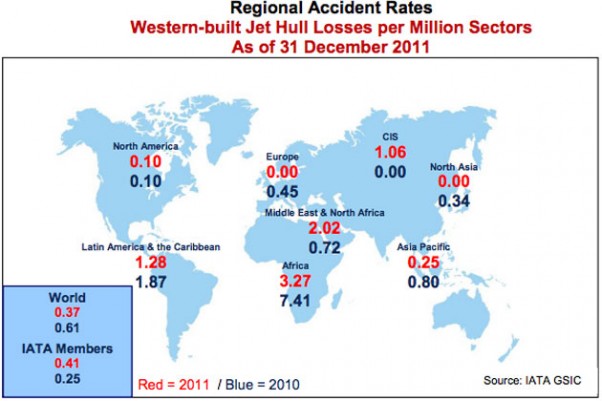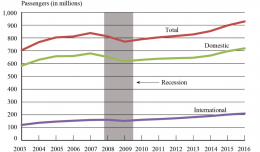Passenger safety improved significantly last year as the numbers of accidents and fatalities reached the lowest in aviation history, the International Air Transport Association (IATA) said on Tuesday. It surpasses the previous low in 2010.
More than 2.8 billion people flew safely on some 38 million flights in 2011, according to estimates from the IATA. The association recorded a total of eleven hull loss accidents involving Western-built jets last year, an improvement of 35 percent when compared to the 17 hull loss accidents in 2010.
The IATA defines a hull loss as an accident in which the aircraft is destroyed or substantially damaged and not subsequently repaired for whatever reason, including a financial decision by the owner. The global accident rate for 2011 is equivalent to one accident in every 2.7 million flights.
“Safety is the air transport industry’s number one priority. It is also a team effort. The entire stakeholder community – airlines, airports, air navigation service providers and safety regulators – works together every day to make the skies safer based on global standards,” said Tony Tyler, IATA’s Director General and CEO. “As a result, flying is one of the safest things that a person could do. But, every accident is one too many, and each fatality is a human tragedy. The ultimate goal of zero accidents keeps everyone involved in aviation focused on building an ever safer industry.”
IATA said 486 people died on Western-built jets and passenger turboprops in 2011, significantly lower than the 786 fatalities in 2010. “Aviation’s good record is not the result of complacency. The strong performance in 2011 should not distract us from the need for continuous improvement to drive the accident rate even lower,” Tyler said. “An even safer future will be built on the foundation stones of global standards, cooperation between industry and government and information sharing.”
But concerns remain as the average hull loss rate for the Middle East and North Africa worsened to 2.02 from 0.72 in 2010. Latin America and the Caribbean performed better than 2010 but was still almost 3.5 times worse than the global average. Africa remains the worst performing region with a rate of 3.27, though down 56 percent compared to 2010.
The deadliest aviation accident of 2011 happened in July when a Royal Moroccan Air Force transport aircraft crashed into a mountain about 10 kilometers (6.2 miles) northeast of Guelmim, the capital of the Guelmim-Es Semara region in southern Morocco. Officials said all 80 people on board were killed in the crash.







